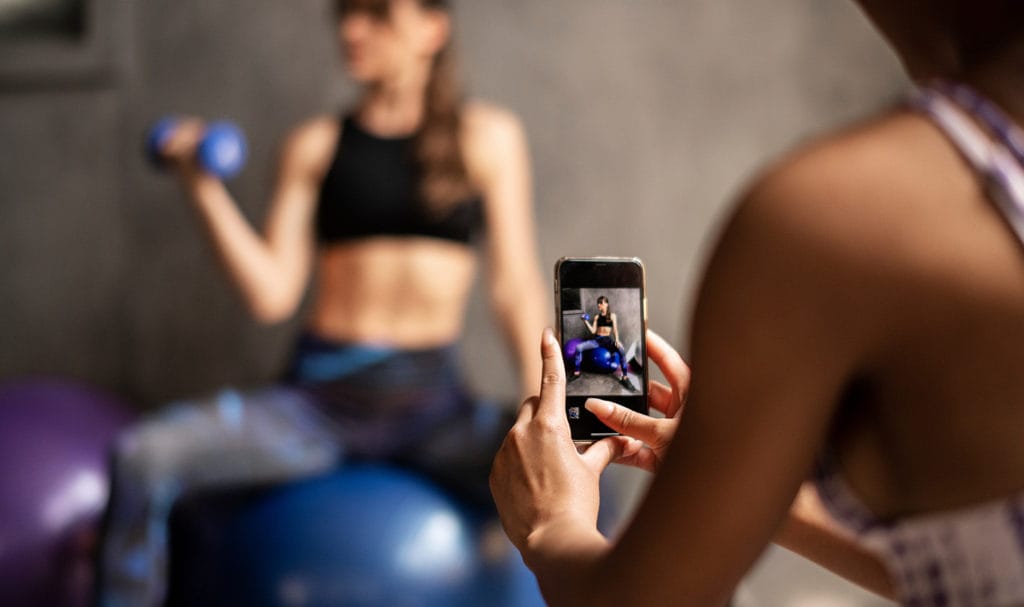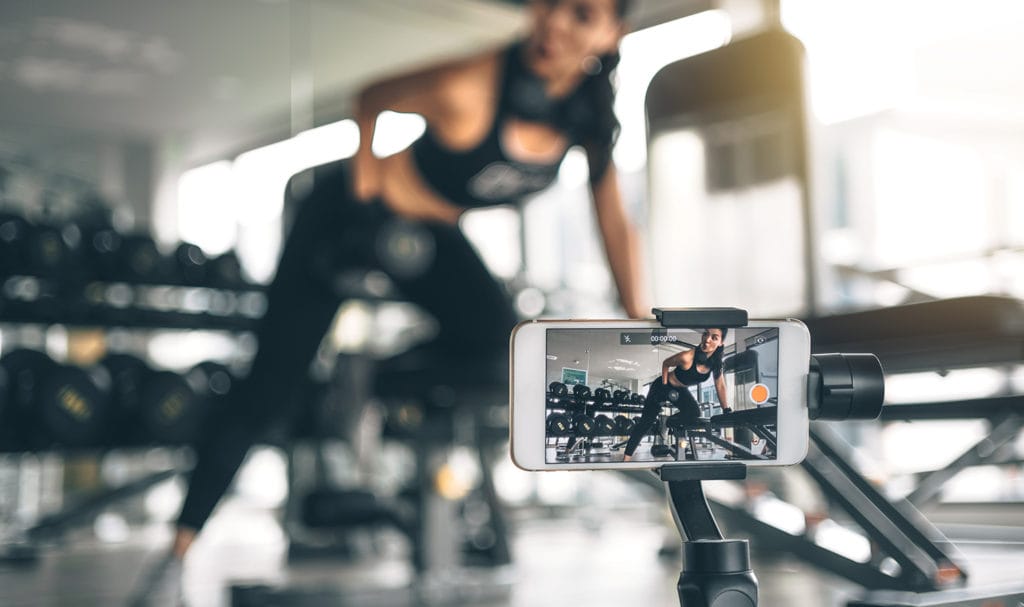Ever felt like navigating the world of online fitness marketing is like trying to do a handstand for the first time? A bit wobbly, but super exciting! Well, buckle up your gym belts, because we’re here to share innovative and effective ways to attract new clients.
Whether you’re coaching one-on-one, streaming online classes, or running a fitness studio that’s the talk of the town, knowing how to flex your marketing muscles is key. This guide is like your spotter in the marketing world, helping you with the digital dumbbells of social media and the heavy lifting of SEO.
Let’s dive into the world where hashtags meet hand weights.
How to Market Your Fitness Business
You might not turn into an advertising heavyweight overnight, but you can start building your marketing muscles with some campaign ideas, examples, and more. We’re breaking down more than two dozen essential marketing strategies across seven different channels into easy-to-understand tips.
![Sweat and Strategy: 7 Digital Marketing Channels for Fitness Success Combine these strategies to create a well-rounded marketing plan that boosts your fitness business’ visibility, engagement, and growth. 1. Social Media: The Community Gym Choose Your Platforms – Instagram, Facebook, TikTok, and YouTube are popular platforms for fitness businesses. Content Creation – Share workout videos, success stories, live sessions, and behind-the-scenes clips. Engagement Tools – Use Stories, Reels, and Shorts for interactive content. 2. Paid Advertising: Your Targeted Campaign Trainer Google AdWords – Use keywords and local targeting for search visibility. Facebook Ads – More precisely target potential and ideal customers. 3. SEO: Your Online Visibility Coach Keywords – Use relevant terms like "fitness classes in [city, state]." Local SEO – Claim your Google Business Profile, and ensure NAP consistency. Content – Start a blog, create custom videos, and share client testimonials. 4. Email Marketing: The Direct Line to Clients Email Content – Send newsletters, fitness tips, promotions, and more. Personalization – Write custom content, use clients’ names, and celebrate milestones. 5. Referral Marketing: Your Client Advocates Referral Rewards – Offer discounts or freebies for successful referrals. System Setup – Have a referral process that’s easy to join and track. Fitness with Friends – Allow clients to bring friends for a mini or session. 6. Affiliate Marketing: Your Partnership Network Collaboration – Partner with local businesses and influencers. Relationship Building – Co-host events and share content. Cross-marketing – Create deals that benefit both businesses. 7. Traditional Marketing: The Local Community Outreach Flyers – Hang eye-catching flyers in high-traffic areas with appealing first-time offers. Newspaper Ads – Place ads in local papers and magazines during key fitness seasons.](https://images.insurancecanopy.com/u/2024/04/26115522/Sweat-Strategy-infographic-mobile-layout-01-scaled.webp?strip=all&lossy=1&ssl=1)
1. Social Media
Social media is more than a place for food photos and selfies. It’s an essential community-building tool for digital marketing.
With it, you can create a space where your audience can learn about your services, share their experiences, and engage with your content and each other.
Choose the Right Platforms
- Assess your target audience and their preferred platforms. For instance, Instagram and Facebook are great for a broad demographic, while TikTok might be better for younger audiences, and YouTube is a great platform for online fitness businesses that create video fitness content.
- Consider the nature of your content; visual platforms like Instagram are perfect for fitness-related imagery while TikTok and YouTube Shorts are perfect for videos.
- Understand your client’s needs. Facebook’s group feature is excellent for connecting with a more private audience where you can build an online community around your brand or in a certain area.
Create Engaging Content
- Share a variety of content, such as workout videos, client success stories, health tips, live Q&A sessions, and behind-the-scenes clips of running your business.
- Use high-quality images and videos. Visual appeal is crucial in fitness marketing. Getting good lighting, a stand for a phone, and free photo editing tools like Canva can help you make quality content with just a smartphone.
- Be authentic and relatable. Let your brand’s personality shine through to create a connection with your audience!
Leverage Stories, Reels, and Shorts
- Utilize Facebook Stories, Instagram Reels, and YouTube Shorts for quick, engaging content. This can be fitness tips, snippets of classes, or motivational messages.
- Conduct polls, ask questions, or use other interactive features in Stories to engage with your audience.
- Post consistently but avoid overwhelming your audience with too much content.
Schedule Posts and Interact with Followers
- Use social media management tools to schedule your posts for times when your audience is most active. Buffer, Hootsuite, and Later are great options.
- Regularly monitor and respond to comments and messages. Engagement is a two-way street! Plus, it shows you’re approachable and willing to chat with clients.
- Encourage user interaction by asking questions, running contests, or starting discussions related to fitness and wellness.

2. Online Advertising
Paid online advertising is a powerful tool for reaching your specific demographics and driving awareness, engagement, and growth quickly. It’s one of the best digital marketing ideas for fitness studios and instructors alike to target their ideal clients.
The biggest thing to note about online ads is they bring fast results, but it isn’t always the best long-term strategy. It may help get people on your site or in the door quicker, but it is a financial investment you need to consistently pay into to see it work.
Increase Your Website Traffic with Google Ads
- Google Ads can help you target potential clients based on specific search queries related to fitness, health, and wellness. For instance, you can try targeting keywords like “fitness classes in [city, state]” or “best online yoga courses.”
- If you have a physical location, local targeting can help you reach people searching in your area. This is particularly effective for drawing local traffic to your studio or gym.
- Utilize ad extensions to easily provide additional information about your business like contact numbers, location, or links to specific pages, like your class schedule or membership plans.
Attract Clients on Social Media with Facebook Ads
- Facebook allows you to target users with specific ads based on key demographics like age, gender, location, interests, and behaviors. Tailor your ads to reach the specific type of clientele you desire, such as young professionals, new mothers, or fitness enthusiasts.
- Use Custom Audiences to retarget people who have visited your website, and use Lookalike Audiences to reach new people who share characteristics with your existing customers.
- Incorporate engaging visuals and compelling copy in your ads, like videos showcasing your classes, images of your facilities, or client success stories. You’ll also want to use clear content that relates to your clients, tells them how your services can benefit them, and offers a clear call to action.
Develop Targeting Strategies
- Understand your audience and personalize your messaging to address their specific fitness goals and interests.
- Regularly test different targeting criteria (like interests, location, and age ranges) to identify which yields the best results.
Create a Budget for Ads
- Start with a modest budget to test your ads so you know which targeting strategies work best. Then slowly increase or decrease your budget based on your results.
- Allocate more time and money to campaigns and ad sets that show promising results.
- Be mindful of the cost-per-click vs. cost-per-impression; clicks are more likely to bring in customers whereas impressions only grow your exposure. Adjust your strategy accordingly to maximize your return on investment (ROI).
Measure Ad Performance
- Utilize analytics tools provided by Google Ads and Facebook Ads Manager to track the performance of your ads.
- Track key metrics and analyze your results. Key metrics to monitor include click-through rate (CTR), conversion rate, cost per conversion, and return on ad spend (ROAS).
- Regularly review and adjust your campaigns based on these insights. Testing different ad elements (like headlines, images, and call-to-actions) can help you optimize your ad performance.
You might want to consider making a budget to pay for a freelancer or marketing agency to help you run ad campaigns.
Not everyone feels ready to take on this type of advertising on their own, and that’s okay! Do what you can and don’t be afraid to hire some help if you need it.

3. SEO
SEO (Search Engine Optimization) is crucial for increasing the online visibility of your fitness business.
SEO is what determines which sites show up each time you search for something online. It’s like a meticulous little robot working behind the scenes to find the best options for you based on the information businesses publish.
Search engines don’t fully disclose how they determine SEO rankings. But there are several tried and true strategies you can use to boost your chances of showing up in search results and getting more eyes on your business.
Understand the Importance of Keywords
- Conduct keyword research to identify terms that potential clients use when searching for fitness services. Tools like Ahrefs or Semrush can help you see which keywords offer the most search potential. For example, if you offer yoga classes, keywords could include “online yoga classes,” “beginner yoga in [city, state],” or “best California yoga studios.”
- Incorporate these keywords naturally into your website’s content. It’s best practice to try to use them in titles, headers, and meta descriptions, but don’t force it or overdo it. Mentioning each keyword once per page is plenty!
Harness the Power of Local SEO for Attracting Nearby Clients
- Optimize for local SEO to attract clients in your area. This includes claiming your free Google Business Profile listing, and ensuring your business’s name, address, and phone number (NAP) are consistent across all online platforms.
- Encourage satisfied clients to leave positive reviews on Google, as this can improve your local search rankings. And be sure to reply to reviews (even the bad ones) to show you are engaged with your clients.
- Include location-specific keywords in your website’s content, such as the name of your city or neighborhood.
Create Fitness-Related Content to Boost Search Rankings
- Regularly publish high-quality, relevant content on your blog. Your topics could range from fitness tips and nutritional advice to success stories and industry trends. You can even use free AI tools like ChatGPT to come up with a list of topics to cover.
- Use a variety of content formats like articles, videos, infographics, and podcasts. This not only appeals to different audiences but can also boost your rankings.
- Ensure that your content is original, authoritative, informative, engaging, and shareable. This increases the likelihood of it being linked to other sites, which can further boost your SEO. Some websites, like WordPress, have blog tools you can add that allow readers to directly share your blog to social media.
Prioritize Mobile Optimization and User Experience
- Ensure your website is mobile-friendly. Roughly 60% of online searches occur on smartphones, so Google favors mobile-optimized sites. It also lowers the chance of someone coming to your site and getting frustrated if it loads too slowly or the font is too small or half the page is cut off the screen.
- Ensure easy navigation and clear calls to action. When users can easily find what they’re looking for on your site and take action, it can reduce bounce rates and improve rankings.
- Provide a good user experience. You can test this by having some friends or family members try using your site and asking them to complete tasks. They can share feedback on what was easy or hard to do.

4. Email
Remember the days of sending postcards in the mail? Well, now you can send them directly to people’s pockets (or wherever their smartphone is stored!)
Email marketing is an essential part of maintaining regular contact with your current and potential clients.
Build an Email List
- Use your website, social media channels, and physical location (if applicable) to encourage email sign-ups. You can do this by posting links online or sharing a QR code in person. Offer incentives like a free workout plan or a discount on first-time memberships to encourage signups.
- Include sign-up forms at various touchpoints: at the end of blog posts, during online class sign-ups, and in your email signature.
- Make your sign-up process easy, quick, and straightforward. Only ask for essential information like someone’s name and email address. Anything else can discourage someone from signing up. You don’t want anyone saying, “Why would you need my blood type for an email? No thanks!”
Send Newsletters, Fitness Tips, and Special Offers
- Send regular newsletters to keep your audience informed about the latest happenings in your business. Include a mix of content like upcoming class schedules, success stories, new program announcements, and health and fitness articles.
- Share fitness tips and advice to provide value to your subscribers. This could be exclusive workout routines, nutrition advice, or wellness strategies.
- Use emails to notify your subscribers of special promotions, discounts, or events. This could be for holiday specials, new year fitness challenges, or summer boot camps.
Personalize Emails to Foster Client Relationships
- Segment your email list based on interests, past purchases, or engagement levels. This allows you to send more targeted, relevant content. For instance, send different emails to those who attend yoga classes versus those who prefer HIIT workouts.
- Personalize emails with the subscriber’s name and write like you’re speaking directly to your clients. It’s also a nice touch to sign off every email with your name.
- Celebrate milestones or acknowledge important dates like birthdays or membership anniversaries with personalized messages. This strengthens your relationship with customers because it shows you care about the little things!

5. Referral
Think about how many times you ask your friends and family for recommendations on things to buy or places to travel to. Or how likely you are to read the reviews before buying a new product. Word-of-mouth referrals are one of the most powerful forms of marketing because of this!
Here’s how you can create a referral program and tap into the influence of recommendations.
Set Up a Referral System
- Choose an incentive (or a few) that you are willing to offer clients who successfully refer new people to your business.
- Make the referral process simple. Clients should be able to easily refer friends and family, possibly through a form on your website, a referral card, or a simple verbal referral tracked at your business.
- Communicate the referral program to your clients through various channels: in-person during sessions, via email, on your website, and through social media.
- Use a referral tracking system to monitor referred clients and ensure the referrer gets the promised rewards. This could be managed through your customer relationship management (CRM) system, fitness referral and loyalty rewards software, or simpler tracking tools like spreadsheets.
- Continually promote your referral program. Mention it in your newsletters, display it in your studio (if you have one), and remind clients during classes or sessions.
- Collect feedback from participants to understand what works and what doesn’t, allowing you to make necessary adjustments to the program.
- Consider creating special referral events or campaigns (like “Bring a Friend Week”) to give an extra boost to your referral efforts periodically.
Offer Incentives for Clients Who Bring Friends or Family
- Offer discounts or free sessions for every new client an existing client refers. For instance, provide a free class for each successful referral or a discount on the next month’s membership.
- Consider non-monetary incentives like exclusive merchandise (branded fitness gear, water bottles, etc.), access to special classes or workshops, or even recognition on your social media channels.
- Create tiered rewards to encourage multiple referrals. For example, the first referral could earn a 5% discount, the second a 10% discount, and three or more could earn a month of free customized meal plans.

6. Affiliate
Affiliate marketing is a performance-based marketing strategy where partners (affiliates) promote your business in exchange for a commission on the sales or leads they generate. It can also take the form of a cross-promotion effort, a content exchange, and more!
It’s a mutually beneficial strategy that can yield impressive results with proper management and collaboration.
Partner With Local Businesses or Fitness Influencers
- Collaborate with a local business that aligns with your fitness brand, such as a health food store, a spa and wellness center, or a boutique that sells fitness attire. These businesses can promote your services to their customers, and vice versa.
- Partner with fitness influencers or bloggers who have a strong following in your niche. They can use their platforms to introduce your business to a broader audience, and you can introduce them to your clients. Even going live together on social media for a Q&A could be fun!
Offer Partner and Customer Incentives
- Set up a commission structure where affiliates earn a percentage of the sales they refer. For example, they could receive a 10% commission for every new client who signs up for your classes through their referral.
- Consider offering their customers a discount on their first class or a free one-on-one fitness consultation in return for a special offer your clients can use with their business.
- Offer to do a podcast interview, write a blog, or film a short social media video sharing your expertise that can be posted by another business while getting you valuable exposure.
Leverage Affiliate Relationships
- Look for opportunities to work with other brands and influencers in the social media space. You can exchange content that aligns with your brand values and resonates with your target audience, such as workout tutorials, fitness challenges, or nutrition advice.
- Organize joint events or campaigns with affiliates to boost visibility and engagement, like a co-hosted fitness challenge or a health and wellness workshop.

7. Traditional
By combining traditional marketing methods with digital strategies, your fitness business can effectively reach a wider audience, build community connections, and have a recognizable brand that brings in new local clients.
Post Flyers
- Design eye-catching flyers with compelling images and information about your fitness services, special offers, class schedules, or upcoming events. Include a QR code for people to easily link to your website or social media. Canva is a great free design tool that offers easy-to-use templates you can customize to your brand.
- Include a call-to-action (CTA), like a free trial class or a discount code for first-time clients to see results quicker and entice more people to check out your business.
- Ask local businesses if you can hang these flyers in high-traffic areas such as local grocery stores, health food shops, community centers, and cafes.
Invest in Local Ads
- Place advertisements in local newspapers or community magazines to reach a broader local audience. This can be particularly effective with neighborhood and community centers that send information about local events and classes to residents.
- Highlight unique aspects of your fitness business, showcase client testimonials, and feature any current promotions or introductory offers.
- Consider timing your ads seasonally around New Year’s, springtime, or other periods when people are more likely to seek out fitness services.
Scope Out Community Event Sponsorships
- Sponsor local community events like charity runs, school sports events, health fairs, or local festivals. Sponsorship can range from financial support to providing fitness-related prizes or services.
- Set up a booth or stand at these events where you can interact with attendees, offer free consultations, and hand out flyers or freebies.
- Demonstrate what your business offers, such as hosting a mini yoga session or teaching people how to find the right workouts for them.
Consider Additional Traditional Marketing Methods
- Direct mail: It might surprise you to learn that 80–90% of direct mail gets opened vs just 20–30% when it comes to email. And 92% of consumers believe direct mail trumps digital ads. Send postcards or brochures to local residents with information about your services, along with an attractive introductory offer.
- Branded merchandise: Distribute branded merchandise like t-shirts, water bottles, or fitness bands at local events or as part of a promotion. And since no one likes stuff with only a giant logo on it, try adding a funny phrase, motivational quote, or a fun graphic that relates to your business and is in line with your branding.
Now that we’ve covered some of our top fitness marketing ideas, here’s how you can apply these methods in real ways to different types of fitness businesses.

How to Market Online Fitness Coaching
Learn how to market your online fitness business with these powerful tips:
Social Media
- Host live workout sessions on platforms like Instagram, Facebook, or YouTube.
- Regularly host Q&A (question and answer) sessions to answer fitness and health-related questions.
- Create online fitness challenges or contests with virtual rewards or recognition.
- Team up with other fitness influencers or brands to do social media takeovers.
- Share what a day in your life is like with your personal workouts, meal prep, and more.
Online Advertising
- Chat with the admins of online community groups or forums about posting ads for your services in their groups about your services, especially if you’re targeting a specific geographical area or community.
- Implement retargeting ads to reconnect with visitors who have interacted with your website or social media but haven’t yet signed up for your services.
- Utilize Google Ads to appear in search results when potential clients look for online fitness coaching or related fitness services.
SEO
- Ensure all images on your website have descriptive alt tags that include relevant keywords. This helps in improving your site’s accessibility and rankings.
- Regularly check your website for any SEO issues, such as broken links, outdated content, or slow loading times, and address them promptly.
- Regularly update your website with engaging and informative content. This could be blog posts about fitness tips, nutrition advice, success stories, or information about different classes and training methods.
Email Marketing
- Provide valuable content such as workout plans, fitness tips, and wellness articles.
- Share success stories and testimonials from members to inspire and motivate others.
Referrals
- Collaborate with nutritionists, physical therapists, and other health professionals in your area who can refer clients to you who are looking for an online fitness coach.
- Offer incentives for clients who refer friends or family, like a discount on their next month’s subscription, a free one-on-one session, or exclusive access to additional content like specialized workout plans.
Affiliate Marketing
- Partner with fitness apps or online platforms and offer exclusive classes or content for their member, giving you extra exposure and a share of the revenue from sign-ups.
- Get a deal with a company that makes fitness apparel or equipment you can use in your videos. You can receive a commission for every sale made through a referral link or code.
- Help promote an upcoming virtual fitness event in exchange for a chance to showcase your coaching services.
Traditional Marketing
- Participate in or co-host events like health fairs, fitness expos, or local races to get exposure in your area.
- Offer to speak at local events, schools, or clubs about fitness and health topics.
- Partner with local gyms and studios to offer workshops or seminars.

How to Market Fitness Classes
Here’s a compilation of dynamic marketing tactics to help you know how to market your fitness classes and amplify your presence:
Social Media
- Encourage your class participants to share their own content—photos or videos from your classes, their fitness journey, etc.—and tag your page.
- Collaborate with other fitness instructors or wellness professionals on social media to cross-promote each other’s content.
- Share before-and-after photos or testimonials of your clients (with their consent) to illustrate the impact of your training.
Online Advertising
- Run ads promoting special offers for new members, such as a discounted rate for the first month or a free trial class.
- If you’re hosting a special event, workshop, or themed class, use paid ads to promote it.
SEO
- Gain backlinks from reputable websites, such as local news sites, fitness blogs, or community websites.
- Mention your city or neighborhood and get listed in local directories and Google My Business.
Email Marketing
- Regularly update clients about class schedules, and send reminders for classes they’ve signed up for or might be interested in.
- Use email to inform your clients about exclusive offers, discounts, or early access to new classes and programs.
Referrals
- Send personalized thank-you notes or emails to clients who refer new members.
- Host a special class with another fitness instructor where students have to bring another person to participate.
Affiliate Marketing
- Collaborate with health-focused businesses like health food stores, sports equipment shops, or wellness centers. You can offer their customers special deals when they enroll in your class, and in return, you can promote their products to your students.
- Create affiliate relationships with local businesses by offering their employees special membership rates or customized wellness programs.
Traditional Marketing
- Talk to a community center about teaching some classes there and getting your info listed on their website and in other marketing materials.
- Host special events, like themed classes for the holidays or raising awareness for a local cause, and promote it in newspapers or radio stations for your area.
- Write guest columns in local newspapers and magazines. Highlight your unique approach to fitness and the benefits of your classes.

How to Market Group Fitness Classes
Here’s a mix of savvy strategies to make your classes the talk of the town:
Social Media
- Post short clips from your classes to showcase the energy and community vibe.
- Use live streaming for portions of your class to give viewers a taste of your sessions.
- Highlight students who reach certain milestones or goals.
- Post quick workout routines, nutritional tips, or wellness advice.
- Use features like polls, quizzes, and questions to gather feedback on class types and schedule preferences.
Online Advertising
- Utilize platforms like Facebook and Instagram to run targeted ads.
- Use Google Ads to target people searching for group fitness classes in your area. Optimize your ads with relevant keywords like “group fitness near me” or “best group exercise classes.”
SEO
- Identify and target keywords that potential clients might use to search for fitness classes in your area. Include these keywords naturally in your website’s content, blog posts, and meta tags.
- Regularly post content that links back to your website.
Email Marketing
- Automate a system to send out birthday emails to clients, possibly including a special offer like a free class or a discount on products or services.
- Create special email campaigns around holidays and seasons, with themed workouts, health tips, or promotions tied to the time of year.
- Regularly inform students of your class schedule, new services, or any changes with time or location for a class.
Referrals
- Have specific days of the week or month where clients can bring a friend to try a class for free.
- Encourage clients to share their experiences on social media and tag you. You can offer a small reward for those whose posts bring in new students.
Affiliate Marketing
- Reach out to bloggers in the fitness and wellness niche. They can write about a special upcoming event, review classes, or share your content, driving their readers to your services.
- Invite popular fitness instructors to co-teach a special fitness class with you.
Traditional Marketing
- Place ads in local newspapers and community magazines. These publications often have sections dedicated to local businesses and events.
- Host free demo classes in public places like parks or community centers to attract new students.
- Create branded merchandise, like t-shirts and water bottles, that can be given away as freebies or sold to create a walking advertisement for your classes.

How to Market Your Fitness Studio
Here’s a blend of fitness studio marketing ideas to help you flex your business muscles in the market:
Social Media
- Share high-quality images and videos of your studio, classes, and success stories.
- Showcase the teachers and trainers in your studio with short bios and fun facts.
- Give behind-the-scenes glimpses of class preparations or studio setups.
- Get your employees to participate in viral trends and Q&As.
- Share your story for starting your studio and tips to help others do the same.
Online Advertising
- Optimize your ads for local keywords such as “fitness studio near [city, zip code, or neighborhood]” or “yoga classes in [Your City].”
- Create visually appealing ads showcasing your studio, classes, and success stories, and target them based on interests, demographics, and location.
SEO
- Cater to the local community by claiming and optimizing your Google Business Page, ensuring your studio is listed in local directories, and using local keywords in your website’s content.
- Encourage your clients to leave positive reviews on Google and other review sites.
Email Marketing
- Send a personalized welcome email to new members with information about the studio, class schedules, and tips for getting started.
- Share a monthly newsletter containing studio news, upcoming events, member success stories, health tips, and nutritional advice.
- Send emails requesting feedback about classes, instructors, or the overall experience at the studio.
Referrals
- Incentivize your current members to become affiliates by offering them benefits like discounts, free classes, or merchandise for bringing new clients to your studio.
- Give out referral cards to your clients, which they can hand to friends and family. These could include a free trial offer or a discount on the first month’s membership for new clients.
Affiliate Marketing
- Partner with local businesses that your clients may be interested in, like a spa or nutritionist. Cross-promote your services and offer discounts to each other’s clients.
- Team up with local fitness influencers or trainers who have a strong social media presence. They can promote your studio, special events, or classes to their followers in exchange for a commission on each referral.
- Establish partnerships with fitness apparel and equipment brands. You can feature their products in your studio and receive a commission for every sale made.
Traditional Marketing
- Distribute flyers and posters to local businesses, community centers, churches, and other places where your potential clients might be found.
- Sponsor community events, get a booth at local conventions, and volunteer in your community to help gain more visibility in your area.
- Contact a local news station, paper, or radio show to share newsworthy events or milestones your studio achieves.

How to Use Certifications and Insurance as Marketing Tools
Your fitness certifications prove that you’re not just passionate, but also knowledgeable and skilled in your field.
Whether it’s a certification in personal training, nutrition, yoga, or specialized fitness regimes, these are your medals of expertise, showcasing your dedication to your craft.
The Best Certifications for Fitness Marketing
With so many certifications, it can be hard to know which is right for you. Some of our top recommended programs that offer the best in fitness education are:
National Academy of Sports Medicine (NASM)
Certified Personal Trainer (CPT)
NASM is ideal for those who want a deep understanding of fitness training techniques, functional training, comprehensive client assessment, and program design.
American Council on Exercise (ACE)
Personal Trainer Certification (CPT)
ACE is a great choice for trainers who want to focus on holistic client wellness, customized program design, client motivation, and understanding client behaviors.
International Sports Sciences Association (ISSA)
Certified Personal Trainer (CPT)
ISSA is recommended for those looking to have a broad understanding of fitness training, nutrition, and the business aspects of personal training.
National Strength and Conditioning Association (NSCA)
Certified Strength and Conditioning Specialist (CSCS)
NSCA is ideal for trainers who want to work with athletes, focus on performance training, and are interested in strength and conditioning.
Yoga Alliance
Registered Yoga Teacher (RYT)
Yoga Alliance is beneficial for trainers aiming to provide holistic and mindful fitness routines, as well as learn a variety of yoga techniques and styles.
American College of Sports Medicine (ACSM)
Certified Personal Trainer (CPT)
ACSM is a great choice for trainers who want to approach training with medical and scientific knowledge.
Pilates Method Alliance (PMA)
Certified Pilates Teacher
PMA is recommended for instructors wanting to focus on comprehensive Pilates methods and safe teaching practices.
Get even more details about the best personal trainer certification programs!

How to Use Your Certificate of Insurance in Your Marketing
When you buy fitness instructor insurance from Insurance Canopy, you instantly get access to a Certificate of Insurance (COI).
- Start by logging in to your online account
- Locate the “Download Documents” section
- Click on “Proof of Insurance” to download your COI
Now you can easily send a copy of your COI to anyone who may need to see it! You can also download a wallet and a display version of your COI to have on hand for events or to display in your gym.
If you have a professional website or social media profile or bio with a gym, fitness club, or online program, you can add that you’re an insured trainer. This helps show potential clients you’re a trustworthy trainer they can count on!
Why Marketing Is Crucial to Your Fitness Business
Think of marketing as your business’ personal trainer.
It’s not just about selling your services—it’s the friendly coach that builds lasting client friendships, the creative routine that sets your brand apart, and the nutrition plan that fuels your business’ growth and success.
It’s less about the hard sell and more about the heartfelt connection.
Connecting With Your Target Clients
Successful marketing starts with a handshake, virtually speaking. It’s about identifying who your clients are, what they need, and where you can find them.
Whether it’s prenatal moms, busy professionals, or fitness newbies, understanding your audience allows you to tailor your messaging, ensuring it resonates and reaches the right ears.
More than broadcasting your services, it’s about starting a conversation that matters to them!
Building Trust and Showcasing Your Expertise
Trust is at the core of any successful business, and your marketing plays a key role in fostering an unwavering bond with your audience.
It allows you to build an environment where clients feel valued, understood, and confident in your expertise.
You can achieve this by:
- Sharing your knowledge and expertise in your industry
- Posting client success stories that showcase the quality and effectiveness of your services
- Being transparent about your services, prices, and what clients can expect
- Regularly engaging with clients online and responding to their comments
- Highlighting your certifications, qualifications, and any other industry accreditation
- Use consistent branding, tone, colors, logos, names, etc. in your marketing materials
Standing Out With Your Niche
A niche is like a secret sauce that makes your brand uniquely irresistible. It’s the thing that sets you apart from other fitness businesses similar to yours.
Whatever your niche is, make it known on your social media, website, and other marketing materials. Don’t just tell your audience what you offer; show them why you’re the best at it.
If your niche is CrossFit training, share videos of your invigorating sessions, or if it’s wellness for seniors, highlight testimonials from clients who’ve transformed their lives.
The goal here is not about appealing to everyone—rather it’s about being the perfect fit for the right someone.
Humanizing Your Brand
At its core, fitness is a very personal journey, and your marketing should reflect this. Share your story, the highs and lows, the challenges and triumphs.
Show your audience the face behind the brand—be it through behind-the-scenes glimpses, personal anecdotes, or sharing your own fitness journey.
This human touch turns your brand from a mere service provider into a trusted companion on someone’s fitness journey.

FAQs About Fitness Marketing
What are the most effective marketing channels for a fitness business?
The most effective marketing channels for a fitness business include social media, word-of-mouth referrals, and partnerships.
Personal recommendations are highly trusted, and each of these channels offers the added benefit of an endorsement from a reliable third party.
How much should I spend to promote my fitness business?
Many marketing experts recommend a small fitness business should spend around 7–8% of its gross revenue on marketing.
This is going to be the total amount you’ve earned from sales before you account for other expenses. So if you make $36,000 annually, a reinvestment of $2,520 ($210 a month) would represent 7% of your gross earnings.
What kind of fitness marketing ideas work best on social media?
The fitness marketing ideas that work best on social media are transformation stories, instructional videos, and interactive polls. You can also increase your online reach by getting influencers to talk about you and inviting your clients to share their stories with your followers.
The best approach to knowing how to market online fitness coaching on social media is often by finding a combination of digital strategies that work best for you. You can then tailor what you do to your specific audience and the unique style of your brand.
What are some of the latest trends in fitness marketing?
Some of the latest trends in fitness marketing include hybrid fitness models, incorporating AI tools, and integrating mental health and wellness into your practice.
You can also jump in front of the camera to make trendy videos or partner with popular fitness brands as a brand ambassador to rep their products.

Keep Growing Your Fitness Business
From the digital realm to traditional avenues, having a solid fitness marketing plan is akin to having a well-rounded workout routine—it’s diverse, adaptable, and consistently engaging.
A balanced mix of strategies is key to elevating your brand in this dynamic fitness industry.
Whether you’re a personal trainer, a group fitness instructor, or an online fitness coach, blending these tactics will not only boost your brand’s visibility but also create a strong, connected community.
Remember, in the world of fitness marketing, it’s not just about the number of clients you gain but about the lasting relationships you build and the value you provide.
Get our top recommendations for fitness tools to make your business plan and marketing strategy even easier!



